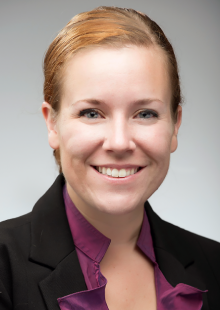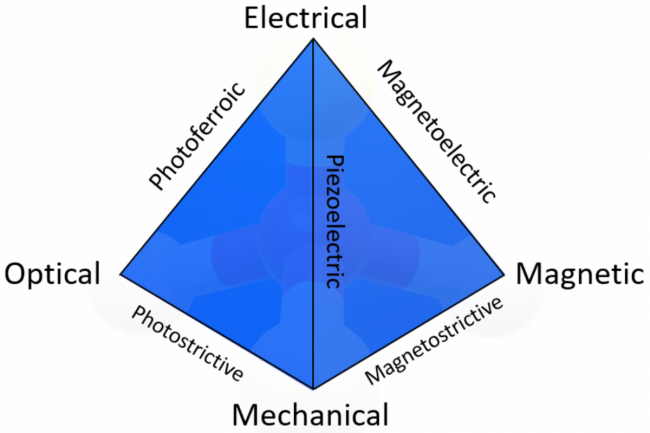
ABOUT
Lauren Garten joined the School of Material Science and Engineering as an assistant professor in Fall 2021. Her group focuses on developing new materials for energy and electronic applications, particularly at the nexus between ferroelectricity, ferromagnetism, electronics, and photovoltaics.
Lauren received her B.S. in ceramic engineering from the Missouri University of Science and Technology. She then went on to earn a Ph.D. in material science from the Pennsylvania State University for her work on ferroelectric, piezoelectric, and dielectric synthesis and characterization with Prof. Susan Trolier-McKinstry. She then became a post-doc at the National Renewable Energy Laboratory working on metastable materials for energy applications. After a very short stint as a material scientist at Sandia National Laboratory, she won the NRC Research Associateship from the National Academies of Science, Engineering, and Math which was hosted at the U.S. Naval Research Lab (NRL). She then received the Jerome and Isabella Karle Distinguished Scholar Fellowship from NRL to work on lead-free multiferroic materials and devices.
PUBLICATIONS & PATENTS
- J. S. Mangum, L. M. Garten, D. S. Ginley and B. P. Gorman (2020). Utilizing TiO 2 amorphous precursors for polymorph selection: An in situ TEM study of phase formation and kinetics, J. Am. Ceram. Soc., jace.16965.
- L. M. Garten, D. Moore, S. Nanayakkara, S. Dwaraknath, P. Schulz, B. Newell, K. Persson, S. Trolier-McKinstry, D. S. Ginley (2019). The Existence and Impact of Persistent Ferroelectric Domains in MAPbI3. Science Advances, 5(1), eaas9311. https://doi.org/10.1126/sciadv.aas9311.
- J. S. Mangum, L. M. Garten, V. Jacobson, D. S. Ginley and B. P. Gorman (2019). Exploring the Link Between Amorphous Structure and Crystallization Behavior of Titania Thin Films by Electron-Based Pair Distribution Functions and in-situ TEM, Microsc. Microanal., 2019, 25, 1506–1507.
- J. S. Mangum, O. Agirseven, J. E.S. Haggerty, J. D. Perkins, L. T. Schelhas, D. A. Kitchaev, L. M. Garten, D. S. Ginley, M. F. Toney, J. Tate, B. P. Gorman (2019). Selective brookite polymorph formation related to the amorphous precursor state in TiO2 thin films. Journal of Non-Crystalline Solids, 505, 109. https://doi.org/10.1016/j.jnoncrysol.2018.10.049.
- L. M. Garten, S. Dwaraknath, J. Walker, J. S. Mangum, P. F. Ndione, Y. Park, D. A. Beaton, V. Gopalan, B. P. Gorman, L. T. Schelhas, M. F. Toney, S. Trolier‐McKinstry, K. A. Persson, D. S. Ginley (2018). Theory-Guided Synthesis of a Metastable Lead-Free Piezoelectric Polymorph. Advanced Materials, 30(25), 1800559. https://doi.org/10.1002/adma.201800559.
- B.-R. Chen, W. Sun, D. A. Kitchaev, J. S. Mangum, V. Thampy, L. M. Garten, D. S. Ginley, B. P. Gorman, K. H. Stone, G. Ceder, M. F. Toney, L. T. Schelhas (2018). Understanding Crystallization Pathways Leading to Manganese Oxide Polymorph Formation. Nature Communications, 9(1), 2553. https://doi.org/10.1038/s41467-018-04917-y.
- S. Siol, A. Holder, J. Steffes, L. T. Schelhas, K. H. Stone, L. M. Garten, J. Perkins, P. Parilla, M. F. Toney, B. D. Huey, S. Lany, A. Zakutayev (2017). Negative Chemical Pressure in Heterostructural Alloys. Science Advances, 4(4), 1442. https://doi.org/10.1126/sciadv.aaq1442.
- L. M. Garten, M. Hagiwara, S. W. Ko, S. Trolier-McKinstry (2017). Physically Based DC Lifetime Model for Lead Zirconate Titanate Films. Applied Physics Letters, 111(12), 122903. https://doi.org/10.1063/1.4994992.
- J. S. Mangum, L.H. Chan, U. Schmidt, L. M. Garten, D. S. Ginley, B. P. Gorman (2017). Correlative Raman Spectroscopy and Focused Ion Beam for Targeted Phase Boundary Analysis of Titania Polymorphs. Ultramicroscopy, 188, 48. https://doi.org/10.1016/j.ultramic.2018.02.007.
- J. Haggerty, L. T. Schelhas, D. A. Kitchaev, J. S. Mangum, L. M. Garten, W. Sun, K. H. Stone, J. D. Perkins, M. F. Toney, G. Ceder, D. S. Ginley, B. P. Gorman, J. Tate (2017). High-Fraction Brookite Films from Amorphous Precursors. Scientific Reports, 7(1), 15232. https://doi.org/10.1038/s41598-017-15364-y.
- X. Kang, S. Shetty, L. M. Garten, J. F. Ihlefeld, S. Trolier-McKinstry, J.-P. Maria (2017). Enhanced Dielectric and Piezoelectric Responses in Zn1-xMgxO Thin Films Near the Phase Separation Boundary. Applied Physics Letters, 110(4) 042903. https://doi.org/10.1063/1.4973756.
- L. M. Garten, M. Burch, A. S. Gupta, R. Haislmaier, V. Gopalan, E. C. Dickey, S. Trolier-McKinstry (2016). Relaxor Ferroelectric Behavior in Barium Strontium Titanate. Journal of the American Ceramic Society, 99(5), 1645. https://doi.org/10.1111/jace.14109.
- L. M. Garten, A. Zakutayev, J. D. Perkins, B. P. Gorman, P. F. Ndione, D. S. Ginley (2016). Structure Property Relationships in Gallium Oxide Thin Films Grown by Pulsed Laser Deposition. MRS Communications, 6 (4) 348. https://doi.org/10.1557/mrc.2016.50.
- L. Schelhas, K. Stone, L. M. Garten, B. Shyam, A. Mehta, P. F. Ndione, D. Ginley, M. Toney (2016). Influence of Amorphous Structure on Polymorphism in Vandia. APL Materials, 4(7), 076103. https://doi.org/ 10.1063/1.4958674.
- H. Ding, S. Dwaraknath, L. M. Garten, D. Ginley, K. Persson (2016). A Computational Approach for Epitaxial Polymorph Stabilization Through Substrate Selection. ACS Applied Material Interfaces, 8(20), 13086. https://doi.org/ 10.1021/acsami.6b01630.
- L. M. Garten, S. Trolier-McKinstry (2015). Enhanced Flexoelectricity Through Residual Ferroelectricity in Barium Strontium Titanate. Journal of Applied Physics, 117(9), 094102 (2015). https://doi.org/10.1063/1.4913858.
- L. M. Garten, S. Trolier-McKinstry (2014). The Field Induced e31,f Piezoelectric and Rayleigh Response in Barium Strontium Titanate Thin Films. Applied Physics Letters, 105(13), 132905. https://doi.org/10.1063/1.4897299.
- L. M. Garten, P. Lam, D. Harris, J.-P. Maria, S. Trolier-McKinstry (2014). Residual Ferroelectricity in Barium Strontium Titanate Thin Film Tunable Dielectrics. Journal Applied Physics, 116(4), 044104. https://doi.org/10.1063/1.4891717.
- M. J. Burch, J. Li, L. M. Garten, X. Sang, J. Lebeau, S. Trolier-Mckinstry, J.-P. Maria, E. C. Dickey (2014). Investigation of Local A-site Chemistry in Barium Strontium Titanate Using Aberration Corrected STEM, EELS and EDS. Microscopy and Microanalysis, 20, 1992. https://doi.org/10.1017/S1431927614011696.
- N. P. Sherlock, L. M. Garten, S. J. Zhang, T. R. Shrout, and R. J. Meyer (2012). Nonlinear Dielectric Response in Piezoelectric Materials for Underwater Transducers. Journal of Applied Physics, 112(12), 124108, https://doi.org/10.1063/1.4770355.
- L. M. Garten, H. Paik, J. Perkins, Z. Jiang, A. Kakekhani, R. Fei, D. Werder, M. Holtz, D. S. Ginley, A. Rappe, D. Schlom, M. Staruch (2020) Stromataxic Stabilization of a Metastable Layered ScFeO3 Polymorph. -In review.
- L. M. Garten, P. Selvarasu, J. Perkins, D. Ginley, A. Zakutayev (2020). Phase Formation of Manganese Oxide Thin Films by Pulsed Laser Deposition. -In review.
- L. M. Garten, K. Williams, M. Cain, N. Bassiri-Gharb, M. Staruch. (2020). Finding Ferroelectricity: A Review of Ferroelectric Characterization Methods. International Materials Reviews, -In review.
- L. M. Garten, M. Staruch (2020) J. Appl. Physics: Domain and Domain Walls in Ferroelectrics, Invited papers, -In progress.
TECHNICAL REPORTS
- Jonathan Anton Bock, Harlan James Brown-Shaklee, Lauren Garten, Carl Fitzgerald, Rudeger HT Wilke. (2019) X7R Ceramic Capacitor Lifetime For Pseudo-DC-Link Topologies. SAND2019-11267C, Sandia National Lab
- V. G. DeGiorgi, L. Garten, P. Finkel and M. Staruch, (2019) Transduction using functional materials: Basic science and understanding at the U. S. Naval Research Laboratory. ASME 2019 Conference on Smart Materials, Adaptive Structures and Intelligent Systems, SMASIS 2019, American Society of Mechanical Engineers.
- Jonathan Anton Bock, Harlan James Brown-Shaklee, Lauren Garten, Rudeger HT Wilke, Carl Fitzgerald, (2019) High Temperature Reliable Dielectrics for DC-link Capacitors. SAND2019-0606C, Sandia National Lab.
- L. M. Garten, D. S. Ginley, S. Dwaraknath, K. Persson, S. Trolier-McKinstry (2019). High Breakdown Strength Ferroelectric SrHfO3 Materials. Full Patent, Application No. 16/255,069.
- L. M. Garten, D. Moore, D. Ginley, B. Gorman (2018). Hybrid Perovskite Bulk Photovoltaic Effect Devices and Methods of Making the Same. Full Patent, Application No. PCT/US18/24140.
- L. M. Garten, D. S. Ginley (2018). Metastable Wide Channel Manganese Oxide Todorokite for Intercalation, Storage, and Filtration. Full Patent, Application No. 62/661,168.
EDUCATION & AWARDS
- Doctor of Philosophy in Material Science and Engineering (2014), The Pennsylvania State University, University Park, PA
- Bachelor of Science in Ceramic Engineering, Magna Cum Laude (2008), University of Missouri-Rolla, Rolla, MO
- The CalTech Young Investigator Lecturer in Engineering and Applied Science. Oct 2020
- The Jerome and Isabella Karle Distinguished Scholar Fellowship (U.S. Naval Research Lab) Oct 2019
- National Research Council Fellowship (The National Academies of Science, Engineering, and Medicine) Oct 2018
- Outstanding Mentor Award (National Renewable Energy Laboratory) Aug 2016
- Postdoctoral Research Competition Award (Department of Energy, Office of Science) Oct 2015
- Opportunity for Undergraduate Research Experience, Research Proposal Award (University of Missouri-Rolla/ MS&T) Apr 2007
- Bright Flight Scholarship (State of Missouri) Aug 2004
RESEARCH INTERESTS
Our group is investigating how material properties can be coupled to create new functionalities or enhanced performance. Specifically, we focus on the synthesis and characterization of ferroelectric thin films and multiferroic heterostructures. In a ferroelectric, the structure and electrical response can be changed by the application of an electric field.

Ferroelectrics are traditionally used in ultrasounds, sonar transducers, actuators, sensors, energy harvesters, adaptive optics, timing standards, radio frequency filters, accelerometers, capacitors, and memory. Here we are developing ferroelectric materials not only for these applications, but also to study how ferroelectricity can be used to enhance charge separation, polarization, and capture when used in or placed adjacent to photovoltaic, catalytic, or magnetic materials.
Research Areas:
• Ferroelectrics
• Multiferroics
• Piezoelectrics
• Flexoelectrics
• Magnetoelectrics
• Photoferroics
• Bulk photovoltaic effect
• Dielectrics in extreme environments
• Metastable materials synthesis